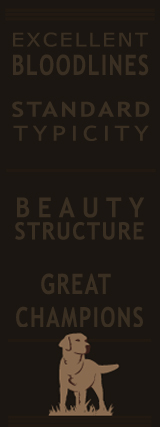The poise of the Labrador
The poise is the direction of the limbs in relation to a horizontal floor. The poise has a marked influence on the topline and hence on the overall demeanor of the Labradors as well as their potential for sports. They determine a good lift, as well as a good distribution of weight on the joints and feet. In general, for the aplomb of a limb to be correct, its principal axis must be vertical.
In fact, a deviation from the vertical implies a stress on joints and plantar surface (near deviation) and therefore premature fatigue of those joints, tendons and different ligaments (which represents, for example, a drawback particularly troublesome for working dogs.). Therefore, the Limbs are not only relevant from a theoretical point of view and aesthetic.
When a dog is planted, dorsolumbar line sinks or is overwhelmed and the back then takes an oblique position. If its black limbs sink too, it is called saddled. In a dog tucked, the back is bent and the back is curved upward. The bowlegged condition is common in the hind limbs, as it is a natural tendency. By contrast, the curved or bandy condition is a serious fault.
Limbs in the forelimbs from the front
Side view or profile: The vertical that goes downward from the midpoint of the arm passes through the middle of the hand and is tangential to the wrist (anterior carpus). If it falls below the midpoint of the hand, the dog is tucked, if it falls behind, it is planted. If the tent is behind that line, the dog is called trascurb. If vertical, it falls away from the paws, the dog has a long pastern, whereas if almost touched, it is called stood pastern.
Front View: The vertical part of the tip of the man should divide equally the forearm, wrist, and hand cane. The two limbs must be in parallel line.
Curved inwards or bowlegged: The wrists and elbow are diverted out, the cane and hands are inward.
Arched outward, or bowlegged left: The elbows are close to the body, while the rods and hands are out. The deviations that characterize and bandy Limbs may begin at any level of the limb.
Open or closed front : the forelegs are oblique and converge or diverge towards their ends. Not to be confused with narrow or wide, a situation in which both limbs are parallel but they are very or somewhat apart. If only the wrists are in, we talk about carpal closed or "carpal ox", whereas if they are bent out of line with aplomb, it is said that the dog is hollow. Limbs are said are lyre-shaped when they present a convexity outward.
Limbs in the hind limbs viewed from behind
Side view or profile: The rod must be perpendicular to the ground and the vertical down from the hip joint must pass through the middle of the foot.
Under itself or set from behind: The limbs as a whole are ahead of that line. If it is seen from behind, the dog is standing, which is not really a flaw, and it is more or less natural. If the hock joint - leg is too tight, it´s a bent hock or a dog sitting on his hocks in the opposite case, a right hock or a dog standing on the hocks.
Seen from behind:The vertical line passing through the point of the buttock and hock divides the rod into equal parts.
The dog may be too closed or too open, which is determined by the convergence or divergence of both limbs at their extremes. Do not confuse these terms with the dogs too narrow or too wide.
When a limb suffers an outward rotation from the hip joint, you get a bow-legged or left member. This is accompanied by divergent knees and feet, while the points of the hocks converge. If the rotation is inward, it is a crooked inward, back or hollow bandy hocks. The knees and feet ends converge, while the tips of the hocks diverge.
Dorsolumbar line (or higher) chest, abdomen
The dorsolumbar line is tamed by the back set. It is almost horizontal in middle-line dogs, saddled in the young and planted up in dogs. The back has a straight profile or horizontal and can be slightly tilted backwards, is bent on longish and lineal animals. The loin is a back to back and tends to be a little wider on the Labrador, which must be powerful and short.
The thoracic cage includes the chest (or ribs), highly convex region formed by the thirteen pairs of ribs. Deep brisket is long (the tip comes back to the last rib) and represents two-thirds of the total length of the dog. The Labrador's chest should be wide.
The abdomen is a cavity behind the diaphragm. It contains several organs essential for the biological functions (the digestive system, the liver, etc.) The flank is a slightly concave area whose length varies depending on the size of the animal. The flank boundary coincides with the belly and it is difficult to see. The underside contains the breasts in the female and the male holds the protective sheath of the penis..


 — Phone: (54 011) 4650-1921 / (54 011) 15-6507-3039
— Phone: (54 011) 4650-1921 / (54 011) 15-6507-3039